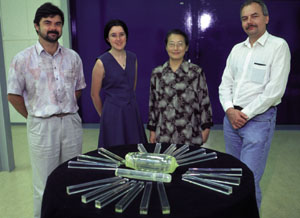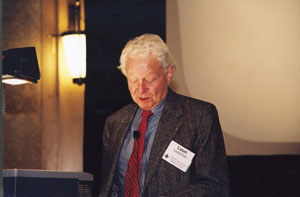Making invisible physics visible has always called for ingenuity. The techniques can also lead to important applications in other areas. Two meetings in Seattle offered an update on developments. Paul Lecoq, Dale Baileyand Christian Michelreport.

The regular IEEE Nuclear Science Symposium is a shop window for developments in technology and instrumentation for both nuclear science and spin-off areas. For both of these directions, one of the highlights of the recent Seattle meeting was the parallel sessions on inorganic scintillators.
Scintillators now form a major focus for calorimetry (energy measurement) in several large high- energy physics detector projects – Belle and BaBar are already in operation with CsI(Tl) crystals, and even bigger projects are under construction, such as the lead tungstate investment for the CMS and ALICE experiments at CERN’s future LHC collider. Other future studies, such as BTeV at Fermilab, and some nuclear physics studies also focus on lead tungstate.
These groups have organized profitable collaborations with crystal manufacturers and producers. Here the goals are to optimize the crystals for the requirements of the particular experiment as well as mass-production.
Such scintillators are also being used increasingly in the important spin-off sector of medical imaging for a new generation of cameras for nuclear medicine. With clinical studies and diagnostics supplemented by basic biomedical research and pharmacokinetics evaluations, this camera market is expanding rapidly. In the quest for optimal image precision and contrast for minimal patient radiation dose, the requirement for high spatial and time resolution somehow clashes with the need for high sensitivity.
Basic research into energy transport and scintillation mechanisms, initiated at CERN and in the US some 10 years ago, help to define guidelines for the development of new, dense, high-light-yield, fast materials. After years of hit and miss, an element of predictability has emerged. For example, it is no surprise that lutetium or gadolinium are the main constituents of most of the new host lattices and that cerium is the favourite luminescence activator for fast scintillation.
Several presentations on lithium- and boron-based scintillators confirmed the rapidly growing interest for new neutron-sensitive materials for use in neutron spallation source projects and the monitoring of nuclear waste.

Medical imaging
Seattle also featured the IEEE Medical Imaging Conference (MIC). This meeting evolved from the traditional Nuclear Science Symposium (NSS) a number of years ago and now runs in parallel under a common organizing umbrella.
This reflects the interest in applying nuclear science techniques in medicine. The identification of the MIC as a mature entity within the same framework as NSS allowed the scope of the NSS/MIC to expand, so that today it is not only the most important meeting in the international calendar for new developments in detectors and acquisition systems for the detection of ionizing and non-ionizing radiation in general, but also the main meeting for presenting new nuclear medicine systems along with algorithms for medical image reconstruction. The number of submitted abstracts was more than 500, shared equally between MIC and NSS.
Chaired by Grant Gullberg and Larry Zeng from Utah, the recent MIC began with a joint session, shared with the NSS, on new detectors for measuring gamma radiation. Solid-state detectors have not yet made great inroads in medical imaging devices, but this session showed that this transition is starting to take place.
In general, there was great interest in new detectors. The field of positron emission tomography (PET) is moving into the vast arena of clinical diagnostic application with established inorganic scintillators (NaI(Tl), bismuth germanate – BGO), but at the same time new detector materials are being incorporated into clinical systems.
Lutetium oxyorthosilicate doped with cerium, originally developed by Schlumberger-Doll for geophysical applications, looks certain to be the detector material for annihilation radiation measurements in medicine for the next decade or more. This scintillator has almost the same stopping power as BGO but offers a much faster decay response time.
Presentations on this exciting new scintillator included a report on the first full PET system built using this set-up by one of the main companies in the field (CTI PET Systems, Knoxville, Tennessee) and the Max Planck Institute in Cologne.
Other topics included new scanners that combine traditional anatomical devices – X-Ray computer tomography (CT), magnetic resonance imaging (MRI) – with features from PET and its gamma-emitting counterpart, single photon emission computed tomography, new algorithms for finding the solution of “inverse problems” encountered in medical imaging, and applications of simulation in the design and testing of imaging systems.

Faster responses
A number of papers focused on the problem of measuring the density distribution of the body for use in correcting for the attenuation of photons, and allowing for the unwanted contribution of Compton scattered photons in images. New detectors with faster response times and improved energy resolution may contribute to this area.
While the meeting was dominated by emission tomography (single-photon and positron emitters), there is increasing interest in MRI, spiral X-Ray CT and other medical imaging methods.
Arrangements are well advanced for the IEEE Nuclear Science Symposium and Medical Imaging Conference 2000 in Lyon in October, the first time that this important meeting will come to Europe. In addition to the usual scientific papers, the organizing committee anticipates increased interest from exhibitors of a highly technical nature, and a number of short courses aimed at PhD student/postdoctoral graduate level in topics of current interest in image reconstruction and multimodality imaging. These would also serve as a useful introduction to an experienced scientist or engineer in high-energy physics who might have an interest in applications in medicine. This year’s NSS/MIC Web site is at “http://nss2000.in2p3.fr/“.








